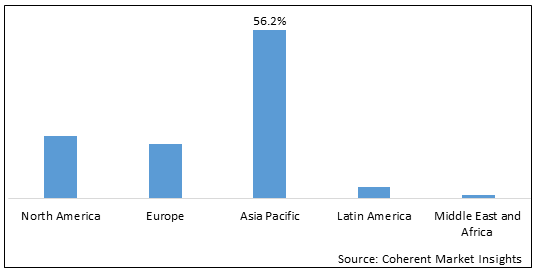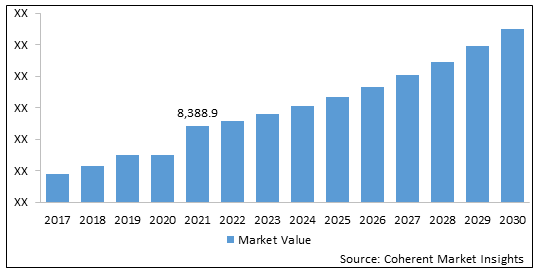Failure analysis is the process of gathering and analyzing data, in order to determine the cause of failure with the objective of determining corrective actions or liability. It is crucial to understand the root cause of failure so as to prevent similar incidents in the future. Some of the common causes include assembly error, misuse or abuse, fastener failure, inadequate maintenance, manufacturing defects, low-quality material, improper heat treatments, unforeseen operating conditions, design errors, insufficient quality assurance, inadequate environmental protection, and casting discontinuities. Failure analysis equipment finds applications in various segments such as fiber optics, semiconductor manufacturing, metallurgy, polymers, life sciences, bio-medical, and nanotechnology.
The global failure analysis equipment market is estimated to account for US$ 8,388.9 Mn in terms of value by the end of 2021 and is expected to grow at a CAGR of 9.2% during the forecasted period (2022-2030).
Market Opportunity
The emergence of innovative technologies such as super-resolution microscopy can present lucrative growth opportunities
Correlative light and electron microscopy (CLEM) combines two microscopy platforms namely electron microscopy and light microscopy. Light microscopy provides 3D quantitative and analytical data with a focus on the analysis of live cells. However, only electron microscopy achieves the highest definition in terms of ultrastructure and protein labelling. Furthermore, EM provides higher-resolution images but only over specific regions of a non-living cell. LM is capable of providing wide field images of both livings as well as non-living cells, however limited. Thus, CLEM allows scientists to spot and zoom cellular structures in the whole cell. Moreover, CLEM techniques provide additional tools for quantitative 3D analysis by adding the third dimension to EM with electron tomography combined with rapid freezing.
Rising demand from emerging economies can provide major business opportunities
Many industries in emerging economies are increasingly adopting failure analysis equipment. This is owing to rising awareness regarding the economic benefits of this system. Industries such as super-conductor and life sciences are adopting this equipment, in order to prevent future failure in their operations. Key companies in the market can capitalize on these opportunities by providing novel products and gain a competitive edge in the market.
Market Restraint
A low adoption rate due to the high cost of equipment is expected to hamper the global failure analysis equipment market growth over the forecast period
Equipment required for failure analysis such as transmission electron microscope (TEM), scanning electron microscope (SEM), and focused ion beam systems are significantly expensive. Each of these pieces of equipment costs over US$ 4 Million, which is naturally hindering their adoption. On the contrary, optical microscopes cost are less expensive than electron microscopes although the latter offers superior features and applications. End users in Asia Pacific have tight budgets for such equipment, which in turn, is expected to hamper the global failure analysis equipment market growth over the forecast period.
Lack of skilled personnel is expected to restrain the growth of the global failure analysis equipment market during the forecast period
Operating and managing failure analysis equipment requires skilled personnel. These individuals are required to possess adequate training and knowledge regarding the equipment. Although such skilled professionals are available in developed countries, there is a dearth of such personnel in emerging regions such as Latin America, the Middle East, Asia Pacific, and Africa. Hence, these factors are expected to restrain the growth of the global failure analysis equipment market during the forecast period.
Failure Analysis Equipment Market Report Coverage
| Report Coverage | Details | ||
|---|---|---|---|
| Base Year: | 2021 | Market Size in 2021: | US$ 8,388.9 Mn |
| Historical Data for: | 2017 to 2020 | Forecast Period: | 2022 to 2030 |
| Forecast Period 2022 to 2030 CAGR: | 9.2 % | 2030 Value Projection: | US$ 18,183.81 Mn |
| Geographies covered: |
|
||
| Segments covered: |
|
||
| Companies covered: |
Key Players Covered in global Failure Analysis Equipment market are Carl Zeiss SMT GmbH, JEOL, Ltd., FEI Company, Veeco Instruments, Hitachi High-Technologies Europe GmbH, TESCAN OSRAY HOLDING, A&D Company, Ltd., Oxford Instruments, Bruker, and Eurofins Scientific |
||
| Growth Drivers: |
|
||
| Restraints & Challenges: |
|
||
Uncover macros and micros vetted on 75+ parameters: Get instant access to report
Global Failure Analysis Equipment Market - Impact of Coronavirus (Covid-19) Pandemic:
Due to the Covid-19 pandemic, many industries witnessed a significant change in their business. There was a significant impact on the failure analysis equipment market, as major players in the APAC region such as China incurred a huge loss due to the increasing COVID-19 virus all over the country. This spread of the virus led to the temporary suspension of various businesses in china.
These factors have restrained the growth of the global failure equipment market during the COVID-19 Pandemic.
Competitive Scenario
Key players Equipment the global Failure Analysis Equipment market include Carl Zeiss SMT GmbH, JEOL, Ltd., FEI Company, Veeco Instruments, Hitachi High-Technologies Europe GmbH, TESCAN OSRAY HOLDING, A&D Company, Ltd., Oxford Instruments, Bruker, and Eurofins Scientific.
Recent Developments:
Forecasted APAC is expected to hold a dominant position in Failure Analysis Equipment market in 2030
Statistics:
APAC held dominant position in the global Failure Analysis Equipment’s market in 2021, accounting for 56.2% share in terms of value, followed North America, Europe, and RoW respectively.
Figure 1: Global Failure Analysis Equipment Market Share (%), By Region, 2021

To learn more about this report, Download Free Sample
APAC is expected to be one of the prominent regions in the global market and witness high growth during the forecast period. This is owing to the high growth of nanotechnology and rising investment in research and education infrastructure.
Figure 2: Global Failure Analysis Equipment Market (US$ Mn) Analysis and Forecast, 2017 – 2030

To learn more about this report, Download Free Sample
The Global Failure Analysis Equipment Market was valued at US$ 8,388.9 Mn in 2021 and is expected to reach US$ 18,183.81 Mn by 2030, growing at a CAGR of 9.2% between 2022 and 2030.
Share
Share
About Author
Ankur Rai is a Research Consultant with over 5 years of experience in handling consulting and syndicated reports across diverse sectors. He manages consulting and market research projects centered on go-to-market strategy, opportunity analysis, competitive landscape, and market size estimation and forecasting. He also advises clients on identifying and targeting absolute opportunities to penetrate untapped markets.
Missing comfort of reading report in your local language? Find your preferred language :
Transform your Strategy with Exclusive Trending Reports :
Frequently Asked Questions
Select a License Type
Joining thousands of companies around the world committed to making the Excellent Business Solutions.
View All Our Clients